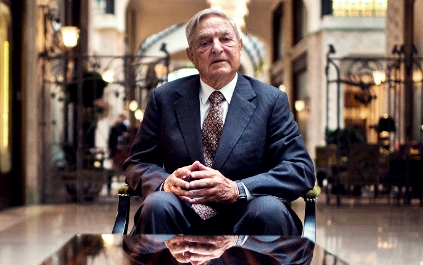Soros Bets $2 Billion on Stock Market Collapse
Newsmax.com
Billionaire investor George Soros has increased his financial bet that U.S. stocks will collapse to more than $2 billion.
The legendary hedge fund manager has been raising his negative bet on the Standard & Poor’s 500 Index since late last year.
The latest 13-F filing with the Securities and Exchange Commission shows that Soros Fund Management increased its position in “puts” on the SPDR S&P 500 exchange-traded fund by a staggering amount in the second quarter from the first.
Editor’s Note: New Warning – Stocks on Verge of Major Collapse
The chairman of Soros Fund Management lifted his position to 11.3 million put options on the S&P 500 ETF (SPY), boosting the short position from 2.96 percent to 16.65 percent. The dollar value of the position soared to $2.2 billion from around $299 million. At 16.65 percent, that position is the biggest slice of the Soros firm’s portfolio.
Many experts see such a put position as a wager that the price of the stock market (in this case the S&P 500) will tumble.
However, some experts warn that such tactics might be part of some long-term trading strategy.
Given that the reported positions are as of June 30, Soros may have made changes since that time.
Friday, the S&P 500 pared earlier declines in the late afternoon, ending the day little changed at 1,955.06. It earlier fell as much as 0.7 percent. The S&P 500 rose 1.2 percent during the week and ended the week 1.7 percent below its all-time high of 1,987.98, reached July 24.
However, Soros’ fund bought 182 new stocks in the second quarter. Soros also lifted positions in Apple and Facebook in a portfolio loaded up with stocks, “so he can’t possibly be all that gloomy,” MarketWatch reported.
Soros nearly doubled his ownership in a U.S. gold-mining companies ETF and initiated new stakes in other gold producers, suggesting the big names in hedge funds continued to have confidence in the yellow metal, Reuters reports.
Soros Fund Management increased its stake in Market Vectors Gold Miners ETF to 2.05 million shares valued at $54 million at the end of the second quarter, compared with 1.16 million shares in the first quarter.
“Gold-mining stocks are considered relatively cheap. It also suggests that Soros may be thinking gold prices are near the bottom of the range,” Bill O’Neill, partner at commodities investment firm LOGIC Advisors in New Jersey, told Reuters.
Soros also initiated new gold investments including 1.33 million shares in call options of the Gold Miners ETF valued at $35 million, and 1 million equity shares in Allied Nevada Gold Corp.
Meanwhile, Soros slashed his stake in Barrick Gold Corp. by more than 90 percent to less than half a million shares valued at just $8.8 million in the second quarter after boosting ownership of the gold miner in the first quarter.
“Gold has become increasingly attractive to hedge-fund managers who are long-term investors as real interest rates remain negative,” said Axel Merk, a Moneynews Insider and chief investment officer of the $400 million Merk Funds, a family of currency mutual funds and the Merk Gold Trust, a gold ETF.
Investors have stayed away from the metal amid mounting speculation that the Federal Reserve will increase its benchmark lending rate. The central bank reduced its monthly bond-buying program to $25 billion on July 30, making a sixth consecutive $10 billion cut, while it held borrowing costs near zero percent.
Goldman Sachs last month repeated its prediction that gold will drop to $1,050 in 12 months. The bank cited accelerating U.S. economic growth. Friday, gold fell 0.9 percent to $1,304.30 an ounce, paring an earlier decline of 1.7 percent.
Speculators decreased bets on a gold rally by 15 percent to 104,111 futures and options in the week ended Aug. 5, the biggest drop in two months, U.S. government data show.
Money managers who oversee more than $100 million in equities must file a Form 13-F within 45 days of each quarter’s end to list their U.S.-traded stocks, options and convertible bonds. The filings don’t show non-U.S. securities or how much cash the firms hold.
Investors pay close attention to the quarterly filings because they provide the best insight into whether the so-called smart money has changed its sentiment toward gold as a hedge against inflation and economic uncertainty.
However, rival money managers cautioned against putting too much weight into what is apparently a pessimistic view of U.S. stocks, given that Soros Fund Management may simply be looking for a hedge to counterbalance its many long stock positions.
“Hedge fund stocks have really gotten destroyed in the last three weeks,” one long-short stock manager told CNBC. “We’re in a difficult time here.”
In September 1992, Soros made at least $2 billion on his shorting of the English pound forced the Bank of England to devalue the currency and leave the European Exchange Rate Mechanism (ERM).
(Bloomberg News and Reuters contributed to this article.)
